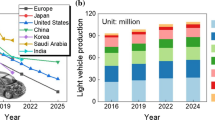Ceramic oxide fibers have low heat conductivity and high heat stability along with low density such that these materials are in demand for high-temperature thermal insulation. However, the creep of oxide fibers at high temperatures limits their use as composite components. We studied the crystallization of oxide fibers with the following compositions (in mass %): 1) 85% Al3O3 + 15% SiO2, 2) 90% Al2O3 + 10% SiO2, and 3) 95% Al2O3 + 4% ZrO2 + 1% Y2O3. The fibers were subjected to heat treatment at 700°, 900°, and 1280°C and we studied their phase composition and strength properties. The greatest tensile strength was found for the first fiber but all the samples showed a tendency for granule growth and loss of strength by the action of high temperatures. Further investigation required to explore possible use of other precursors and the effect of technological conditions on the formation and crystallization of such fibers.








Similar content being viewed by others
References
E. N. Kablov, Ekspert, No. 15(941), 49-53 (2015).
E. N. Kablov, B. V. Shchetanov, et al., Trudy VIAM Elektron. Nauchn.-Tekhnich. Zhurn., No. 2, 5 (2013), URL: http://www.viam-works.ru (access date November 8, 2018).
USA Patent 3,503,765, High Temperature Alumina-Silica Fibers and Method of Manufacture, No. 527,105, Application February 14, 1966, Published March 31, 1970.
USA Patent 4,047,965, Non-frangible Alumina-Silica Fibers, No. 683,183, Application May 4, 1976, Published September 13, 1977.
J. M. Heintz, J. C. Bihr, and J. F. Silvain, J. Europ. Ceramic Soc., 19, 1759-1767 (1999).
M. Schmücker, H. Schneider, et al., J. Europ. Ceramic Soc., 25, 3249-3256 (2005).
X. Song, Q. Gao, et al., “Thermally Stable Boron-containing Mullite Fibers Derived from a Monophasic Mullite Sol,” Ceramics International, https://doi.org/10.1016/j.ceramint.2018.09.301 (circulation date November 6, 2018).
S. Pfeifer, P. Demircib, et al., J. Europ. Ceramic Soc., 36, 725-731 (2016).
W. Wang, D. Weng, and X. Wu, Progr. in Natural Sci.: Materials Intern., 21, 117-121 (2011).
J. Chandradass and M. Balasubramanian, J. Europ. Ceramic. Soc., 26, 2611-2617 (2011).
A. M. Zimichev and P. M. Varrik, Trudy VIAM: Elektron. Nauch.-Tekhnich. Zhurn., No. 6, 6 (2014), URL: http://www.viam-works.ru (circulation date November 6, 2018), doi: https://doi.org/10.18577/2307-6046-2014-0-6-6-6.
Author information
Authors and Affiliations
Corresponding author
Additional information
Translated from Khimicheskie Volokna, Vol. 51, No. 6, pp. 22-29, November-December, 2019.
Rights and permissions
About this article
Cite this article
Varrik, N.M., Zimichek, A.M., Sumin, A.V. et al. Preparation of Continuous Aluminum Oxide Fibers with Silicon Oxide and Zirconium Oxide Additives. Fibre Chem 51, 430–436 (2020). https://doi.org/10.1007/s10692-020-10127-4
Published:
Issue Date:
DOI: https://doi.org/10.1007/s10692-020-10127-4




